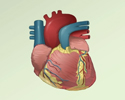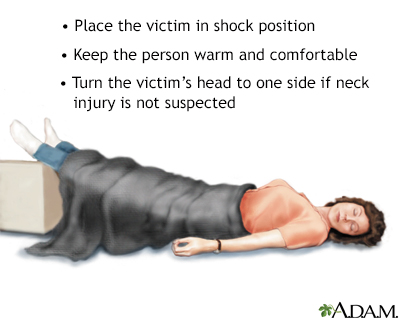Shock
Shock is a life-threatening condition that occurs when the body is not getting enough blood flow. Lack of blood flow means the cells and organs do not get enough oxygen and nutrients to function properly. Many organs can be damaged as a result. Shock requires immediate treatment and can get worse very rapidly. As many as 1 in 5 people in shock will die from it.
Considerations
The main types of shock include:
- Cardiogenic shock (due to heart problems)
Cardiogenic shock
Cardiogenic shock takes place when the heart is unable to supply enough blood and oxygen to the organs of the body.
 ImageRead Article Now Book Mark Article
ImageRead Article Now Book Mark Article - Hypovolemic shock (caused by too little blood volume)
Hypovolemic shock
Hypovolemic shock is an emergency condition in which severe blood or other fluid loss makes the heart unable to pump enough blood to the body. This ...
Read Article Now Book Mark Article - Anaphylactic shock (caused by allergic reaction)
Anaphylactic shock
Anaphylaxis is a life-threatening type of allergic reaction.
 ImageRead Article Now Book Mark Article
ImageRead Article Now Book Mark Article - Septic shock (due to infections)
Septic shock
Septic shock is a serious condition that occurs when a body-wide infection leads to dangerously low blood pressure.
Read Article Now Book Mark Article - Neurogenic shock (caused by damage to the nervous system)
- Obstructive shock (caused by something outside of the heart which prevents the heart from pumping enough blood)
Causes
Shock can be caused by any condition that reduces blood flow, including:
- Heart problems (such as heart attack or heart failure)
Heart attack
Most heart attacks are caused by a blood clot that blocks one of the coronary arteries. The coronary arteries bring blood and oxygen to the heart. ...
 ImageRead Article Now Book Mark Article
ImageRead Article Now Book Mark ArticleHeart failure
Heart failure is a condition in which the heart is no longer able to pump oxygen-rich blood to the rest of the body efficiently. This causes symptom...
 ImageRead Article Now Book Mark Article
ImageRead Article Now Book Mark Article - Low blood volume (as with heavy bleeding or dehydration)
Bleeding
Bleeding is the loss of blood. Bleeding may be:Inside the body (internal)Outside the body (external)Bleeding may occur:Inside the body when blood le...
 ImageRead Article Now Book Mark Article
ImageRead Article Now Book Mark ArticleDehydration
Dehydration occurs when your body does not have as much water and fluids as it needs. Dehydration can be mild, moderate, or severe, based on how much...
 ImageRead Article Now Book Mark Article
ImageRead Article Now Book Mark Article - Changes in blood vessels (as with infection or severe allergic reactions)
Severe allergic reactions
Anaphylaxis is a life-threatening type of allergic reaction.
 ImageRead Article Now Book Mark Article
ImageRead Article Now Book Mark Article - Certain medicines that significantly reduce heart function or blood pressure
- Slow heart rates and changes in blood vessel tone from spinal injuries
- A collapsed lung (pneumothorax)
Collapsed lung
A collapsed lung occurs when air escapes from the lung. The air then fills the space outside of the lung between the lung and chest wall. This buil...
 ImageRead Article Now Book Mark Article
ImageRead Article Now Book Mark Article
Shock is often associated with heavy external or internal bleeding from a serious injury.
Toxic shock syndrome is an example of shock that is caused by an infection.
Toxic shock syndrome
Toxic shock syndrome is a serious and potentially life-threatening disease that involves fever, shock, and problems with several body organs....

Symptoms
A person in shock has extremely low blood pressure. Depending on the specific cause and type of shock, symptoms will include one or more of the following:
- Anxiety or agitation/restlessness
Anxiety
Stress is a feeling of emotional or physical tension. It can come from any event or thought that makes you feel frustrated, angry, or nervous. Stres...
 ImageRead Article Now Book Mark Article
ImageRead Article Now Book Mark Article - Bluish lips and fingernails
Bluish lips and fingernails
A bluish color to the skin or mucous membrane is usually due to a lack of oxygen in the blood. The medical term is cyanosis.
 ImageRead Article Now Book Mark Article
ImageRead Article Now Book Mark Article - Chest pain
Chest pain
Chest pain is discomfort or pain that you feel anywhere along the front of your body between your neck and upper abdomen.
 ImageRead Article Now Book Mark Article
ImageRead Article Now Book Mark Article - Confusion
Confusion
Confusion is the inability to think as clearly or quickly as you normally do. You may feel disoriented and have difficulty paying attention, remembe...
 ImageRead Article Now Book Mark Article
ImageRead Article Now Book Mark Article - Dizziness, lightheadedness, or faintness
Dizziness
Dizziness is a term that is often used to describe 2 different symptoms: lightheadedness and vertigo. Lightheadedness is a feeling that you might fai...
 ImageRead Article Now Book Mark Article
ImageRead Article Now Book Mark ArticleFaintness
Fainting is a brief loss of consciousness due to a drop in blood flow to the brain. The episode most often lasts less than a couple of minutes and y...
Read Article Now Book Mark Article - Pale, cool, clammy skin
- Low or no urine output
Low or no urine output
Decreased urine output means that you produce less urine than normal. Most adults make at least 500 milliliters of urine in 24 hours (a little over ...
 ImageRead Article Now Book Mark Article
ImageRead Article Now Book Mark Article - Profuse sweating, moist skin
Profuse sweating
Sweating is the release of liquid from the body's sweat glands. This liquid contains salt. This process is also called perspiration. Sweating helps...
 ImageRead Article Now Book Mark Article
ImageRead Article Now Book Mark Article - Rapid but weak pulse
- Shallow breathing
Shallow breathing
Most people take breathing for granted. People with certain illnesses may have breathing problems that they deal with on a regular basis. This arti...
 ImageRead Article Now Book Mark Article
ImageRead Article Now Book Mark Article - Being
unconscious (unresponsive)
Unconscious
Unconsciousness is when a person is unable to respond to people and activities. Health care providers often call this a coma or being in a comatose ...
 ImageRead Article Now Book Mark Article
ImageRead Article Now Book Mark Article
First Aid
Take the following steps if you think a person is in shock:
- Call 911 or the local emergency number for immediate medical help.
- Check the person's airway, breathing, and circulation. If necessary, begin rescue breathing and CPR.
CPR
CPR stands for cardiopulmonary resuscitation. It is an emergency life-saving procedure that is done when someone's breathing or heartbeat has stoppe...
Read Article Now Book Mark Article - Even if the person is able to breathe on their own, continue to check rate of breathing at least every 5 minutes until help arrives.
- If the person is conscious and does not have an injury to the head, leg, neck, or spine, place the person in the shock position. Lay the person on their back and elevate their legs about 12 inches (30 centimeters). Do not elevate their head. If raising the legs will cause pain or potential harm, leave the person lying flat.
- Give appropriate first aid for any wounds, injuries, or illnesses.
- Keep the person warm and comfortable. Loosen tight clothing.
IF THE PERSON VOMITS OR DROOLS
- Turn the person or their head to one side to prevent choking if you do not suspect an injury to the spine.
- If a spinal injury is suspected, "log roll" the person instead. To do this, keep the person's head, neck, and back in line, and roll the body and head as a unit.
Do Not
In case of shock:
- Do not give the person anything by mouth, including anything to eat or drink.
- Do not move the person with a known or suspected spinal injury.
Spinal injury
The spinal cord contains the nerves that carry messages between your brain and the rest of the body. The cord passes through your neck and back. A ...
 ImageRead Article Now Book Mark Article
ImageRead Article Now Book Mark Article - Do not wait for milder shock symptoms to worsen before calling for emergency medical help.
When to Contact a Medical Professional
Call 911 or the local emergency number any time a person has symptoms of shock. Stay with the person and follow the first aid steps until medical help arrives.
Prevention
Learn ways to prevent heart disease, falls, injuries, dehydration, and other causes of shock. If you have a known allergy (for example, to insect bites or stings), carry an epinephrine pen. Your health care provider will teach you how and when to use it.
Heart disease
Coronary heart disease is a narrowing of the blood vessels that supply blood and oxygen to the heart. Coronary heart disease (CHD) is also called co...

Dehydration
Dehydration occurs when your body does not have as much water and fluids as it needs. Dehydration can be mild, moderate, or severe, based on how much...

Reviewed By
Jesse Borke, MD, CPE, FAAEM, FACEP, Attending Physician at Kaiser Permanente, Orange County, CA. Also reviewed by David C. Dugdale, MD, Medical Director, Brenda Conaway, Editorial Director, and the A.D.A.M. Editorial team.
Angus DC. Approach to the patient with shock. In: Goldman L, Cooney KA, eds. Goldman-Cecil Medicine. 27th ed. Philadelphia, PA: Elsevier; 2024:chap 92.
Puskarich MA, Jones AE. Shock. In: Walls RM, ed. Rosen's Emergency Medicine: Concepts and Clinical Practice. 10th ed. Philadelphia, PA: Elsevier; 2023:chap 3.
Smith SG, Schreiber MA. Shock, electrolytes, and fluid. In: Townsend CM Jr, Beauchamp RD, Evers BM, Mattox KL, eds. Sabiston Textbook of Surgery. 21st ed. St Louis, MO: Elsevier; 2022:chap 4.

 All rights reserved.
All rights reserved.